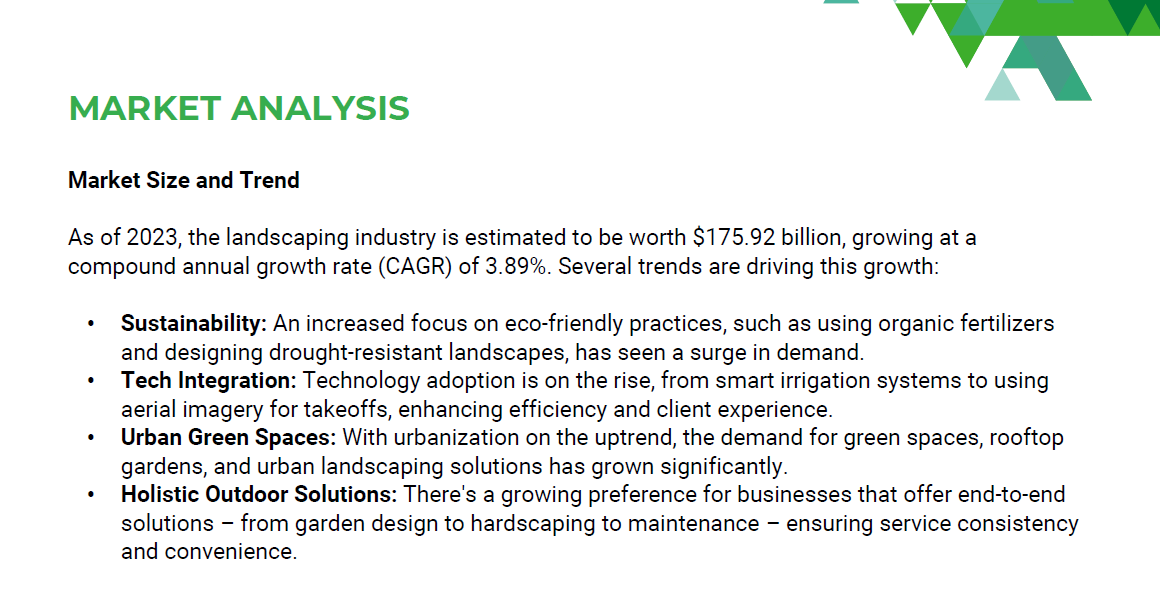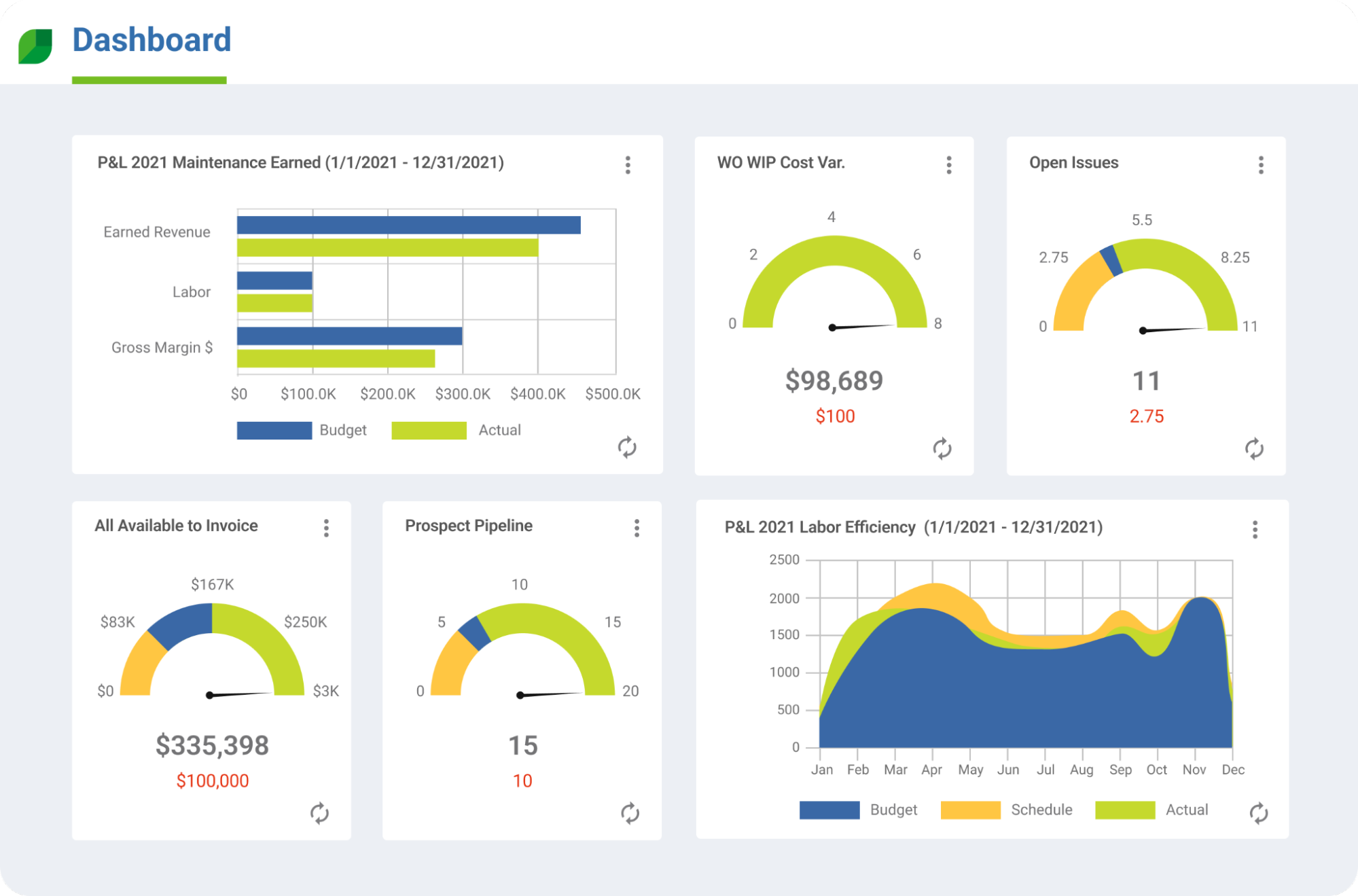

A landscape business plan is essential for securing bank loans, managing startup costs, and maintaining cash flow. Even the most seasoned landscape business owner needs a dynamic roadmap to guide operations and inform goal-setting.
Annually reviewing and adjusting your company’s business plan helps you to scale your landscape business strategically.
This article describes what to include in a landscape business plan and provides a free landscape business plan template to get started.
>> Download Aspire’s FREE landscape business plan template.
The executive summary serves as a strategic snapshot of your landscape business plan. It should be compelling to capture the attention of potential partners and lenders.
The executive summary briefly describes the new business, its mission, and its goals. Summarize the most critical aspects of the plan, such as:
If you’re applying for funding, specify the amount, how you intend to use it, and, more importantly, how it will increase your profit margins.
Even though the executive summary comes first in the plan, write it last to identify and highlight the most crucial elements of your plan, ensuring that it presents a well-rounded and compelling case for your landscape business.

The company overview is where you start to dig into the details of your landscaping or lawn maintenance business. It should include specifics, such as:
In addition to the nuts and bolts, a company overview is where business owners state their mission statement, vision statement, and core values. This gives the reader a comprehensive understanding of the company’s business identity.
In this section, list your various landscaping services, such as routine lawn care services, landscape design, or mulch installation. For each service type, detail the:
List any specialized equipment or certifications that enable you to perform unique services or differentiate you in the marketplace. Also, determine whether you plan to provide these services to homeowners, commercial clients, or both.
Some landscape companies in colder climates pivot to snow removal during the winter. If that’s a part of your business model, include the related services in this section. This demonstrates your capacity to diversify and sustain your business during off-peak seasons, contributing to overall revenue stability and client retention.
Next, outline your pricing strategy, including the pricing model or models your business uses, such as flat-rate, project-based, or hourly pricing. Note that pricing depends on factors like:
You may also list prices from a few competitors to show where your business stands in the marketplace. Include how your pricing strategy positions your business, whether as a cost leader, a premium service provider, or a value-driven option.
Explain if your pricing strategy allows flexibility, such as offering package deals or customizing services based on client preferences. If applicable, discuss strategies to attract and retain clients, such as:

Include a market analysis within your business plan to show potential investors and partners what the landscape industry looks like in your area, such as:
Identify market gaps, whether certain services are not offered, or areas are not sufficiently served.
Discuss emerging trends and innovations within the landscaping industry. This could encompass:
Your awareness of industry trends indicates your readiness to adapt and stay competitive.
In addition, outline your target audience or buyer persona, including demographics and psychographics. If your key target market includes discerning families, this could help determine specific service offerings, such as organic cleaning products and methods.
In the competitor analysis section of your business plan, list the top landscape industry players in your service area and their strengths and weaknesses. Discuss competitive advantages that set the business apart and strategies for outperforming competitors, which may include capitalizing on the weaknesses of your peers.
→ When performing a competitive analysis, due diligence requires consulting market research and industry benchmarks. This guides strategic decision-making.
In addition, detail the marketing and promotional tactics employed by competitors, including their:
Explain how your marketing efforts aim to stand out or compete effectively.
You’ve already established your target audience. Now, outline how you plan to reach potential customers and convert them into new customers. List your marketing channels and tactics, like direct mail, email marketing, and social media marketing.
When crafting a marketing strategy, consider each step of the buyer journey and how your company will effectively target customers through those steps, which include:
For your sales strategy, define your approach, such as value-based or consultative selling.
In addition, define your follow-up strategy for unsold estimates–consider what will convert them–and how to utilize customers you’ve serviced to garner reviews and referrals.

Your management plan provides an overview of the company’s business structure and key personnel responsible for executing the business plan. It acts as a roadmap for:
You may start with an organizational chart, which provides an overview of the company hierarchy from the management team on down. Then, go into further detail, listing the roles and responsibilities of each team member.
A company’s recruitment and retention relies on quality management. Discuss strategies for attracting and retaining talent and your plans for talent development and growing your landscape business. This could include mentorship programs, career pathing, and feedback mechanisms.
The financial plan breaks down the numbers side of your landscaping business, outlining the company’s economic viability and the leadership’s financial acumen.
For businesses seeking funding, outline the capital requirements to start the company and how the money will be used. Include personal income statements for each owner and major stockholder, showing assets and liabilities outside the business and personal net worth.
A financial plan should include financial statements, such as:
Take into account the average profit margins for a landscaping business. Also, list financial risks and mitigation strategies.
→ Your financial plan is a moving target, as you can’t always predict and plan for changing economic landscapes. Regularly revisiting and updating this section of your business plan is crucial.

You might use resources to help implement your financial plan, such as landscape business software like Aspire, which provides visibility into every aspect of operations.
With real-time data readily accessible via custom reports and dashboards, and features to accurately and immediately calculate job costs, Aspire helps landscaping businesses make informed decisions to improve:
A landscape or lawn care business plan helps secure funding, uncover your business differentiators, and guide day-to-day landscape business operations. Check out our sample business plan to get started.
Field service software helps implement the business plan, leading to growth, profitability, and landscape business success.
Aspire’s end-to-end business management software delivers industry-leading features for:
For more than a decade, landscape contractors have trusted Aspire’s tools to help them operate profitably and efficiently.